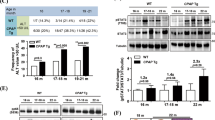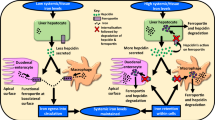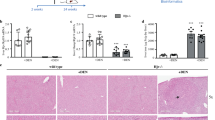Abstract
Hypoxia-inducible factor-1α (HIF-1α) is involved in the pathogenesis of hepatocellular carcinoma (HCC). However, the roles of trace elements in the activation of HIF-1α during hepatocarcinogenesis have been unclear. We investigated whether copper (Cu) and zinc (Zn) participated in the activation of HIF-1α in the process of hepatocarcinogenesis or not. Nine patients with chronic hepatitis (CH), five with liver cirrhosis (LC), 12 with HCC, and nine normal healthy controls were enrolled in this study. Their serum HIF-1α, Cu, and Zn levels were determined in the enrolled patients. Hepatic HIF-1α expression was evaluated, using an immunohistochemical procedure. The HCC patients had significantly higher serum HIF-1α levels than the CH patients (6.47 ± 1.57 vs. 5.09 ± 1.22 ng/ml, p = 0.0344). The serum Cu level in the HCC patients was also significantly higher than those in the CH and LC patients (137 ± 24 vs. 107 ± 15 μg/dl, 114 ± 24 μg/dl). Interestingly, a positive correlation was observed between serum HIF-1α and Cu levels in the enrolled patients (r = 0.425, p = 0.0137). In contrast, no significant differences in serum Zn levels were present between the HCC patients and the CH or LC patients. The serum HIF-1α was not positively correlated with the serum Zn level in the enrolled patients, either. Immunohistochemical analysis revealed that two of the five HCC patients had HIF-1α expression in the tumor tissues, whereas none of CH and LC had hepatic HIF-1α expression in the liver tissues. These data suggest that the activation of HIF-1α derived from a Cu accumulation in the liver may cause hepatocarcinogenesis.





Similar content being viewed by others
References
Semenza GL (1999) Regulation of mammalian O2 homeostasis by hypoxia-inducible factor 1. Annu Rev Cell Biol 15:551–578
Wang GL, Jiang BH, Rue EA, Semenza GL (1995) Hypoxia-inducible factor 1 is a basic-helix-loop-helix-PAS heterodimer regulated by cellular O2 tension. Proc Natl Acad Sci U S A 92:5510–5514
Dimova EY, Kietzmann T (2010) Hypoxia-inducible factors: post-translocational crosstalk of signaling pathways. Methods Mol Biol 647:215–236
Semenza GL (2002) HIF-1 and tumor progression: pathophysiology and therapeutics. Trends Mol Med 8:S62–S67
Zhong H, Chiles K, Feldser D, Laughner E, Hanrahan C, et al. (2000) Modulation of hypoxia-inducible factor-1 alpha expression by the epidermal growth factor/phosphatidylinositol 3-kinase/PTEN/AKT/FRAP pathway in human prostate cancer cells: implications for tumor angiogenesis and therapeutics. Cancer Res 60:1541–1545
Box AH, Demetrick DJ (2004) Cell cycle kinase inhibitor expression and hypoxia-induced cell cycle arrest in human cancer cell lines. Carcinogenesis 25:2325–2335
Piret JP, Minet E, Cosse JP, Ninane N, Debacq C, Raes M, Michiels C (2005) Hypoxia-inducible factor-1-dependent overexpression of myeloid cell factor-1 protects hypoxic cells against tert-butyl hydroperoxide-induced apoptosis. J Biol Chem 280:9336–9344
Tanaka H, Yamamoto M, Hashimoto N, Miyakoshi M, Tamakawa S, et al. (2006) Hypoxia-independent overexpression of hypoxia-inducible factor 1α as an early change in mouse hepatocarcinogenesis. Cancer Res 66:11263–11270
Huang GW, Yang LY, Lu WQ (2005) Expression of hypoxia-inducible factor 1α and vascular endothelial growth factor in hepatocellular carcinoma: impact on neovascularization and survival. World J Gastroenterol 11:1705–1708
Yao DF, Jiang H, Yao M, Li YM, Gu WJ, et al. (2009) Quantitative analysis of hepatic hypoxia-inducible factor-1a and its abnormal gene expression during the formation of hepatocellular carcinoma. Hepatobiliary Pancreat Dis Int 8:407–413
Dai CX, Gao Q, Qiu SJ, Ju MJ, Cai MY, et al. (2009) Hypoxia-inducible factor-1 alpha, in association with inflammation, angiogenesis and MYC, is a critical prognostic factor in patients with HCC after surgery. BMC Cancer 9:418. doi:10.1186/1471-2407-9-418
Gurusamy K (2007) Trace element concentration in primary liver cancers-a systemic review. Biol Trace Elem Res 118:191–206
Asare GA, Mossanda KS, Kew MC, Paterson AC, Kahler-Venter CP, Siziba K (2005) Hepatocellular carcinoma caused by iron overload: a possible mechanism of direct hepatocarcinogenicity. Toxicology 219:41–52
Ebara M, Fukuda H, Hatano R, Yoshikawa M, Sugiura N, et al. (2003) Metal contents in the liver of patients with chronic liver disease caused by hepatitis C virus. Oncology 65:323–330
Maeda T, Shimada M, Harimoto N, Tsujita E, Maehara S, et al. (2005) Role of tissue trace elements in liver cancers and non-cancerous liver parenchyma. Hepato-Gastroenterology 52:187–190
Okuno T, Shimamura Y, Mizuno M, Miyata S, Miyake T, et al. (1988) Trace elements in hepatoma tissues. Trace Elem Med 5:130–136
Martin F, Linden T, Katschinski DM, Oehme F, Flamme I, et al. (2005) Copper-dependent activation of hypoxia-inducible factor (HIF)-1: implications for ceruloplasmin regulation. Blood 105:4613–4619
Nardinocchi L, Pantisano V, Puca R, Porru M, Aiello A, et al. (2010) Zinc downregulates HIF-1α and inhibits its activity in tumor cells in vitro and in vivo. PLoS One 5:e15048. doi:10.1371/journal.pone.0015048
Lifschits MD, Henkin RI (1971) Circadian variation in copper and zinc in man. J Appl Physiol 31:88–92
Ichida F, Tsuji T, Omata M, Ichida T, Inoue K, et al. (1996) New Inuyama classification: new criteria for histological assessment of chronic hepatitis. Int Hepatol Commun 6:112–119
Li S, Yao D, Wang L, Wu W, Qiu L, et al. (2011) Expression characteristics of hypoxia-inducible factor-1a and its clinical values in diagnosis and prognosis of hepatocellular carcinoma. Hepat Mon 11:821–828
Liang B, Zheng CS, Feng GS, Wu HP, Wang Y, et al. (2010) Correlation of hypoxia-inducible factor-1alpha with angiogenesis in liver tumors after transcatheter arterial embolization in an animal model. Cardiovasc Intervent Radiol 33:806–812
Miatto O, Casaril M, Gabrielli GB, Nicoli N, Bellisola G, et al. (1985) Diagnostic and prognostic value of serum copper and plasma fibrinogen in hepatic carcinoma. Cancer 55:774–778
Hatano R, Ebara M, Fukuda H, Yoshikawa M, Sugiura N, et al. (2000) Accumulation of copper in the liver and hepatic injury in chronic hepatitis C. J Gastroenterol Hepatol 15:786–791
Ebara M, Fukuda H, Hatano R, Saisho H, Nagato N, et al. (2000) Relationship between copper, zinc and metallothionein in hepatocellular carcinoma and its surrounding liver parenchyma. J Hepatol 32:415–422
Sugawara N, Sugawara C, Sato M, Takahashi H, Mori M (1992) Excessive accumulation of hepatic copper in LEC rats aged 80 days without hepatitis and 130 days with hepatitis. Pharmacol Toxicol 71:321–324
Himoto T, Yoneyama H, Deguchi A, Kurokohchi K, Inukai M, et al. (2010) Insulin resistance derived from zinc deficiency in non-diabetic patients with chronic hepatitis C. Exp Ther Med 1:707–711
Pramoolsinsap C, Promvant N, Komindr S, Lerdverasirikul P, Srianujata S (1994) Serum trace metals in chronic viral hepatitis and hepatocellular carcinoma in Thailand. J Gastroenterol 29:610–615
Poo JL, Rosas-Romero R, Montemayor AC, Isoard F, Uribe M (2003) Diagnostic value of copper/zinc ratio in hepatocellular carcinoma: a case control study. J Gastroenterol 38:45–51
Xie H, Kang YJ (2009) Role of copper in angiogenesis and its medical implications. Curr Med Chem 16:1304–1314
Matsumoto A, Hanayama R, Nakamura M, Suzuki K, Fujii J, Tatsumi H, Taniguchi N (1998) A high expression of heme oxygenase-1 in the liver of LEC rats at the stage of hepatoma: the possible implication of induction in uninvolved tissue. Free Radic Res 28:383–391
Feng W, Ye F, Xue W, Zhou Z, Kang J (2009) Copper regulation of hypoxia-inducible factor-1 activity. Mol Pharmacol 75:174–182
Kim I, Kim CH, Seo GH, Kim HS, Lee J, Kim DG, Ahn YS (2008) Inhibitory effect of hypoxic HIF-1 activation in astrocytes. Neuroreport 19:1063–1066
Wada H, Nagano H, Yamamoto H, Yang Y, Kondo M, et al. (2006) Expression pattern of angiogenic factors and prognosis after hepatic resection in hepatocellular carcinoma: importance of angiopoietin-2 and hypoxia-induced factor 1α. Liver Int 26:414–423
Nath B, Szabo G (2012) Hypoxia and hypoxia inducible factors: diverse roles in liver diseases. Hepatology 55:622–633
Osaki S, Da J, Frieden E (1966) The possible significance of the ferrous oxidase activity of ceruloplasmin in normal human serum. J Biol Chem 241:2746–2751
Miles SL, Fischer AP, Joshi SJ, Niles RM (2015) Ascorbic acid and ascorbate-2-phosphate decrease HIF activity and malignant properties of human melanoma cells. BMC Cancer. doi:10.1186/s12885-015-1878-5
Author information
Authors and Affiliations
Corresponding author
Ethics declarations
Conflict of Interest
The authors declare that they have no conflict of interest.
Rights and permissions
About this article
Cite this article
Himoto, T., Fujita, K., Nomura, T. et al. Roles of Copper in Hepatocarcinogenesis via the Activation of Hypoxia-Inducible Factor-1α. Biol Trace Elem Res 174, 58–64 (2016). https://doi.org/10.1007/s12011-016-0702-7
Received:
Accepted:
Published:
Issue Date:
DOI: https://doi.org/10.1007/s12011-016-0702-7




